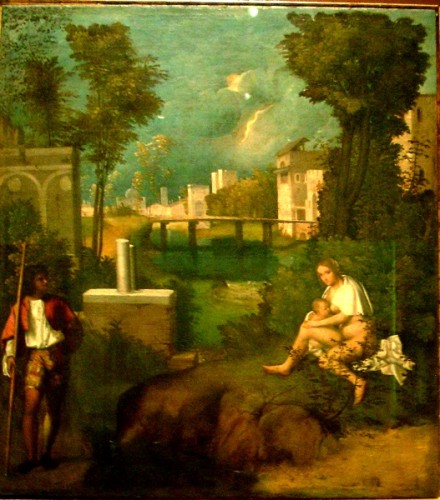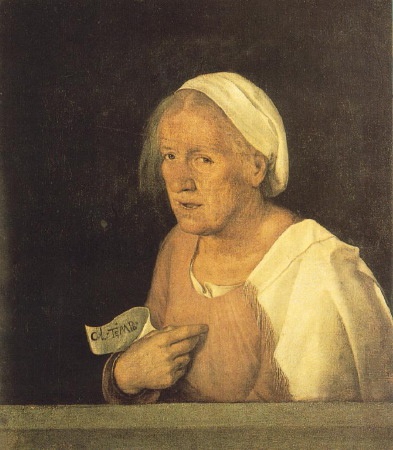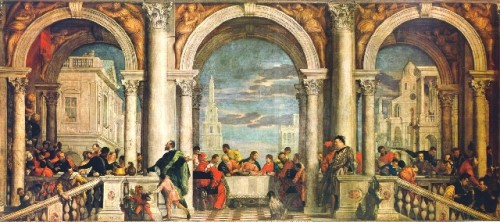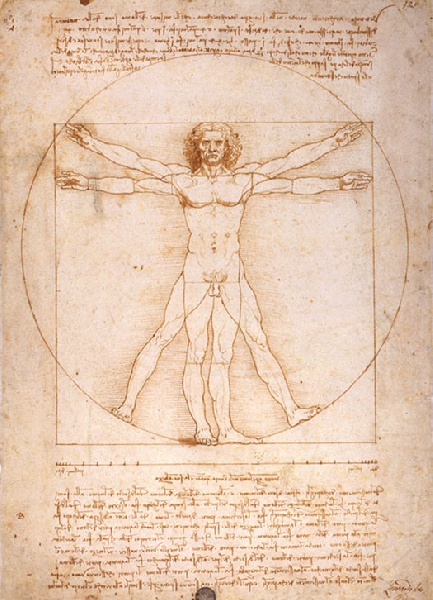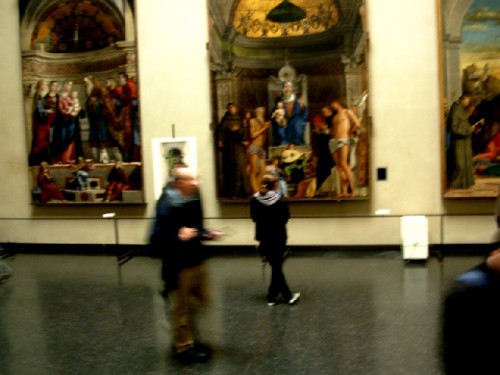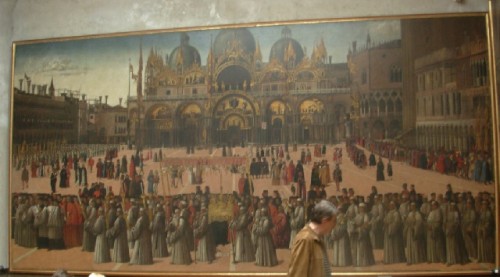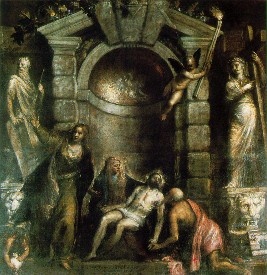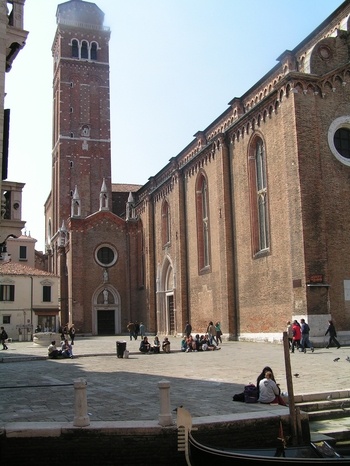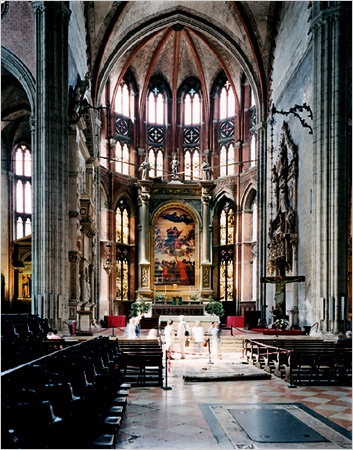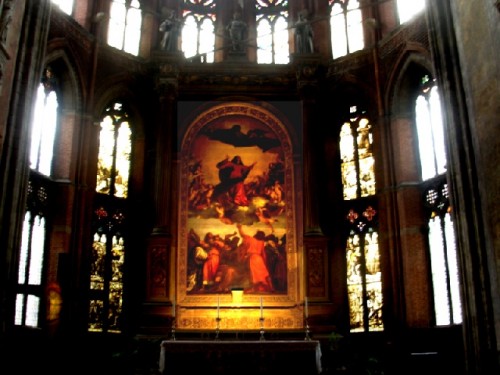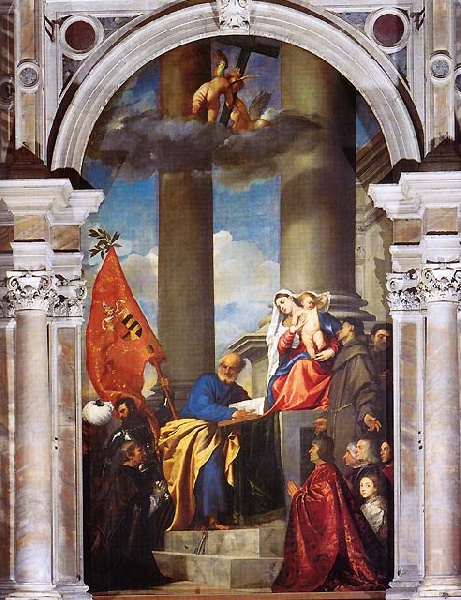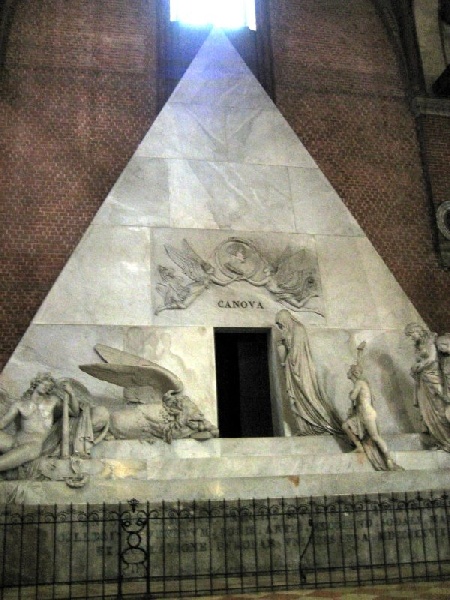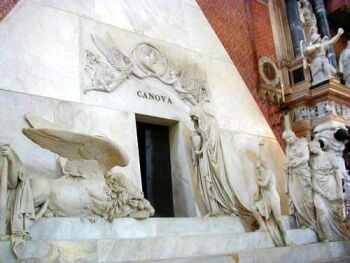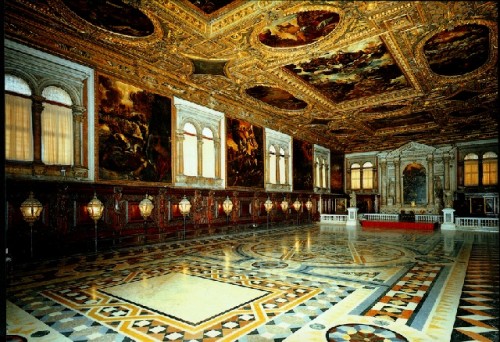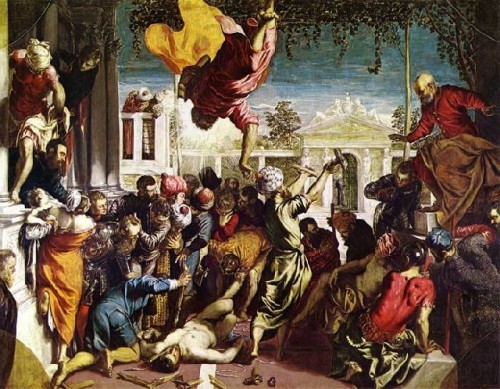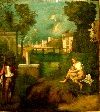Art in Venice
Accademia, Scuola di San Rocco, Frari
By: Charles Giuliano - Jan 05, 2008
In addition to the pure visual feast of just being in Venice our primary mission was to fully experience the Biennale with its enormous range of contemporary work. It is odd to view cutting edge art in a setting so saturated with the sublime. To quote Samuel Taylor Coleridge "Water, water everywhere but not a drop to drink." During our week long visit, water not just in the lagoons, but a steady drizzle, cold and damp as well. There were only a few breaks in the clouds and sunny patches now and then.
Having absorbed as much as we could of the Biennale, as well as the pure joy of exploring the winding alleys and piazzas to and from Piazza San Marco, ferrying up and down the canal by vaparetto, as well as visiting its last stop, The Lido, we set aside a couple of days devoted to seeking out museums and churches.
Conveniently, our hotel at the Centro Culturale Don Orione Artigianelli, in Dorsoduro, was just steps to the Accademia, one of the greatest of the Italian museums. And from the Accademia just two vaparetto stops to San Toma and a short walk to the two great sites Scuola di San Rocco, and literally next door, the magnificent church the Frari. So these three destinations filled a day. On another rainy afternoon, we found our way to the Peggy Guggenheim Museum and Santa Maria della Salute. Both of which were a short walk from Don Orione. But that is another story.
It is often a surprise to find that some of the greatest museums, monuments and sites in Italy often appear to be in states of decline and neglect. This is astonishing in view of the enormous value and historical significance of the works in question. There is such an abundance of riches in Italy that it encourages a condition of apathy. When visiting museums, for lack of staff and money, often rooms are closed, for days, months and even years. Or, if a gallery is open, it may be poorly lit and lack the universal standards for climate control. On the other hand, when a site is upgraded to modern specifications, the conditions for visiting are so restricted that one must make bookings weeks and months in advance. Which is why we came away from two visits to Milan never having viewed da Vinci's "Last Supper." The last time I actually saw it was 1959. But we were fortunate this time, as I have reported, to see the famous fresco cycle by Giotto in Padova for all of fifteen minutes. During the summer of 1975, during an extended visit, I often would stay an extra day in a small city because the museum would open only half of the galleries on a daily basis. One had to return the next day to see the entire collection. Staying an extra day in a small Italian town is not that much of a hardship, if you have the time.
There is another familiar Italian trick in which they often darken the churches by covering the windows. If you want to view a famous monument there is a coin box which illuminates it for about three minutes. It is a good idea to bring a powerful flashlight in your back pack. Or fill your pockets with coins.
So there were mixed responses of stumbling about in the Venetian museums and churches. There was that flutter of the heart and quickened pulse to be standing in front of one of the greatest of all Italian paintings "The Tempest" by Girogione in the Accademia, the numerous paintings by Tintoretto, in Scuola di San Rocco, the Titian Altar Pieces "The Assumption" and the "Pesaro Madonna" as well as the tomb of Canova in the Frari. Wow. Be still dear heart. But also a bit of a strain to actually try to See these magnificent works. A bit of track lighting here and there could go a long way particularly given the great advances in contemporary museology.
On the other hand, one just becomes more amused and Italian with time and experience. There are cultural reasons why things don't work or fall into disrepair. In the great National Archaeological Museum in Naples, for example, I was standing in front of Roman era sculptures, masterpieces that I taught in art history classes, and could hardly see them. There was a bare light hanging from a cord. If it burned out, nobody bothered to replace it. When nobody was looking I ran my finger through the dust on a statue. The wall labels were often typed onto index cards decades ago and stuck to the wall with now ancient scotch tape. Oh my. But there is also an odd charm to all this and the familiar notion that Ars longa. Vita brevis est.
As the city of light there was an enormous impact of color and luminosity in the greatest painters of the Renaissance in Venice. They perfected the subtle techniques of glazing or applying thin translucent layers of overpainting using complex mediums of varnish, thick linseed oil, wax and other materials. It was Titian (1485-1576) who stated that "Oil painting was invented in order to paint flesh." He was the student of Giorgione (1477-1510) and took his great inventive sense of color to the next level and was, arguably, the greatest painter of his generation. Titian was the favorite artist of the Holy Roman Emperor, Charles V (1500-1556), so there are many great works in the Prado in Madrid as well as in the Kunsthistoriche Museum in Vienna.
But to see Titian in situ one must visit the Frari in Venice for the great altar pieces. The Fransiscans were not that thrilled with 'The Ascension" when it was installed over the main altar in 1518. But when Charles V offered a handsome price to acquire it they thought better of their complaints that some of the figures of the Apostles appeared to be too large and out of proportion to the smaller, ascending Virgin. Through the science of physics and technique of perspective the artist was seeking a dramatic view but the priests argued that the Virgin should not be seen as smaller is size and prominence than the Apostles. Charles V rightly viewed it as a great masterpiece. Even the British critic, John Ruskin (1819-1900), voiced his reservations that there was too much "fox color" and that it was "not one whit the better for being either large or gaudy in colour." But Ruskin proclaimed the "Pesaro Madonna," which is also located in the Frari, "The Best Titian in Venice."
Also located in the Frari is the large, pyramid shaped, mausoleum with figures of weeping mourners entering its interior which was initially designed as a tomb for Titian by Antonio Canova (1757-1822) but never built. When Canova died it was created according to his design by his students for the burial of the master. It is one of the great examples of neo classical sculpture.
One should plan to spend enough time in the Accademia to fully appreciate its many rooms and the style of the great Venetian masters. The early galleries present the primitives of the Gothic period in elaborate, ornately carved and gilded altar pieces. But the true Venetian School begins with Jacopo Bellini (1400-1470) and his sons Gentile (1429-1507) and Giovanni (1430-1516). I have always found the decorative painting by Carlo Crivelli (1432-1495) with their curious garlands of fruits and flowers oddly fascinating. One sees a lot of Crivelli in the Accademia. Vittore Carpaccio (1455 to 1526) painted large scale, genre scenes of Venetian ceremonies with their elaborate costumes and the exotically attired Turkish ambassadors. The other great Renaissance masters include Giorgione, Titian, Tintoretto (1518-1594) andVeronese (1487-1553). The masters of a later generation include the ceiling painter Tiepolo (1696- 1770) and the great Vedute or landscape painters Canaletto (1697-1768) and Guardi (1712-1793) as well as the genre paintings of Longhi (1707-1785). There are works by all of these masters on view in the Accademia.
While we may appreciate many of the great Venetian masters for their many works in European and American museums in order to appreciate Tintoretto one must visit Venice. Touring the Doge's Palace and its many rooms decorated by this master and his assistants one wonders if he was a painter or in the wall paper business. He covered more square feet of walls than perhaps any other artist in history. Much of it today is rather dark and turgid notable mostly for its expanse. But a visit to Scuola di San Rocco is quite another matter. Here on two floors we see him in all of his magnificence and invention. The rooms are dark and overwhelmingly ornate. Again, it is challenging to truly view and absorb the individual works but the whole of it, the overall experience, is absolutely riveting. Oddly enough, for many years it was neglected and rarely visited until it was rediscovered by Ruskin.
We were exhausted but exhilarated by our magnificent experience of Venetian art. What better activity for a blustery, rainy fall day. To shun the cold and damp but fill your eyes and heart with that sublime color and light. Bottom line, any day is a good day in Venice.

